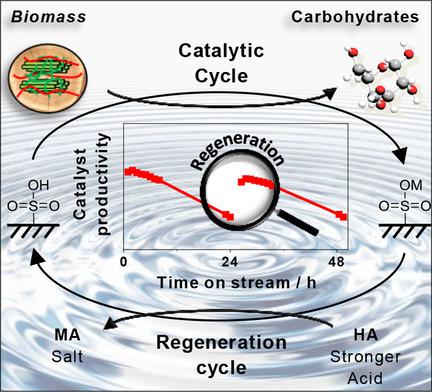当前位置:
X-MOL 学术
›
ChemSusChem
›
论文详情
Our official English website, www.x-mol.net, welcomes your
feedback! (Note: you will need to create a separate account there.)
Deactivation and Regeneration of Sulfonated Carbon Catalysts in Hydrothermal Reaction Environments
ChemSusChem ( IF 7.5 ) Pub Date : 2018-06-06 , DOI: 10.1002/cssc.201800678 David Scholz 1, 2 , Oliver Kröcher 1, 2 , Frédéric Vogel 1, 3
ChemSusChem ( IF 7.5 ) Pub Date : 2018-06-06 , DOI: 10.1002/cssc.201800678 David Scholz 1, 2 , Oliver Kröcher 1, 2 , Frédéric Vogel 1, 3
Affiliation

|
The deactivation pathways of sulfonated carbon catalysts prepared from different carbons were studied during the aqueous‐phase hydrolysis of cellobiose under continuous‐flow conditions. The sulfonation of carbon materials with a low degree of graphitization introduced sulfonic acid groups that are partially stable even during prolonged exposure to harsh hydrothermal treatment conditions (180 °C). The physicochemical characterization of hydrothermally treated materials coupled with the treatment of model compounds for sulfonic acids demonstrated that the stability is related to the presence of activating and deactivating substituents on the aromatic system. Besides sulfonic acid group leaching, a hitherto unknown mode of deactivation was identified that proceeds by the ion exchange of cations contained in the aqueous feed and protons of the sulfonic acid groups. Proton leaching is a fully reversible mode of deactivation by the treatment of the spent catalysts with strong Brønsted acids. Through a combined approach of physicochemical characterization, catalytic testing, and hydrothermal treatment, a methodology for the preparation of catalytically stable carbon materials that bear sulfonic acid groups was established.
中文翻译:

水热反应环境中磺化碳催化剂的失活和再生
在连续流动条件下纤维二糖的水相水解过程中,研究了由不同碳制备的磺化碳催化剂的失活途径。石墨化程度低的碳材料的磺化会引入磺酸基,即使长时间暴露于苛刻的水热处理条件下(180°C),磺酸基团也部分稳定。经水热处理的材料的物理化学特性与用于磺酸的模型化合物的处理相结合表明,稳定性与芳族系统上活化和失活取代基的存在有关。除了磺酸基浸出 确定了迄今未知的失活模式,该失活模式是通过含水进料中的阳离子和磺酸基的质子的离子交换而进行的。通过用强布朗斯台德酸处理废催化剂,质子浸出是一种完全可逆的失活方式。通过物理化学表征,催化测试和水热处理的组合方法,建立了一种制备具有磺酸基的催化稳定碳材料的方法。
更新日期:2018-06-06
中文翻译:

水热反应环境中磺化碳催化剂的失活和再生
在连续流动条件下纤维二糖的水相水解过程中,研究了由不同碳制备的磺化碳催化剂的失活途径。石墨化程度低的碳材料的磺化会引入磺酸基,即使长时间暴露于苛刻的水热处理条件下(180°C),磺酸基团也部分稳定。经水热处理的材料的物理化学特性与用于磺酸的模型化合物的处理相结合表明,稳定性与芳族系统上活化和失活取代基的存在有关。除了磺酸基浸出 确定了迄今未知的失活模式,该失活模式是通过含水进料中的阳离子和磺酸基的质子的离子交换而进行的。通过用强布朗斯台德酸处理废催化剂,质子浸出是一种完全可逆的失活方式。通过物理化学表征,催化测试和水热处理的组合方法,建立了一种制备具有磺酸基的催化稳定碳材料的方法。











































 京公网安备 11010802027423号
京公网安备 11010802027423号